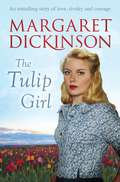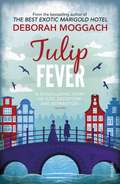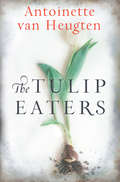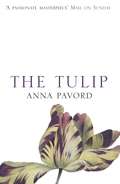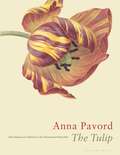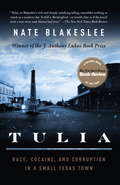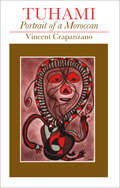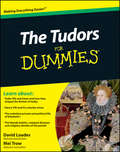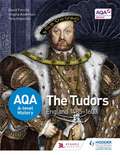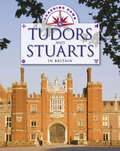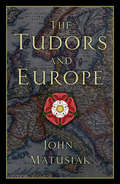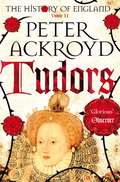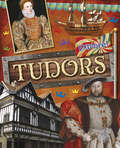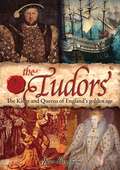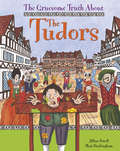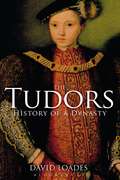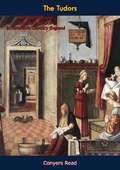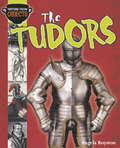- Table View
- List View
The Tulip Girl
by Margaret DickinsonAbandoned outside an orphanage as a newborn baby, spirited Maddie March has had to fight her way through life. So when she finds a home at Few Farm with Frank Brackenbury and his household, she welcomes the chance for a fresh start. Work on the farm is hard, but believing herself truly loved for the first time in her young life by the farmer's son, Michael, even the animosity of the housekeeper Mrs Trowbridge cannot mar Maddie's newfound happiness. 1947 brings harsh winter, sweeping devastation over the farm and threatening the Brackenburys' livelihood. All seems lost, until Maddie has an idea that might save them all from poverty. But then she discovers she is pregnant . . . The Tulip Girl is Margaret Dickinson's captivating Lincolnshire saga about the endurance of true love in the face of adversity.
Tulip Fever
by Deborah MoggachSoon to be a major film starring Oscar winners Alicia Vikander, Christoph Waltz and Dame Judi Dench, and adapted for the screen by Sir Tom Stoppard.From the bestselling author of The Best Exotic Marigold Hotel comes a thrilling story of power, lust and deception set in seventeenth-century AmsterdamSeventeenth-century Amsterdam – a city in the grip of tulip fever. Sophia’s husband Cornelis is one of the lucky ones grown rich from this exotic new flower. To celebrate, he commissions a talented young artist to paint him with his beautiful young bride. But as the portrait grows, so does the passion between Sophia and the painter; and ambitions, desires and dreams breed an intricate deception and a reckless gamble.
The Tulip Eaters (Mira Ser.)
by Antoinette van HeugtenIn a riveting exploration of the power the past wields over the present, critically acclaimed author Antoinette van Heugten writes the story of a woman whose child’s life hangs in the balance, forcing her to confront the roots of her family’s troubled history in the dark days of World War II…
The Tulip: Twentieth Anniversary Edition
by Anna PavordTHE TULIP is not a gardening book. It is the story of a flower that has made men mad. Greed, desire, anguish and devotion have all played their part in the development of the tulip into the world-wide phenomenon it is today. No other flower has ever carried so much cultural baggage; it charts political upheavals, illuminates social behaviour, mirrors economic booms and busts, plots the ebb and flow of religious persecution. Pavord tells how the tulip arrived from Turkey and took the whole of Western Europe by storm. Sumptuously illustrated from a wide range of sources, this beautifully produced and irresistible volume will become a bible, a unique source book, a universal gift book and a joy to all who possess it.
The Tulip: Twentieth Anniversary Edition
by Anna PavordA twentieth anniversary edition of the classic, featuring new material by the author. Anna Pavord's internationally bestselling sensation, The Tulip, is the story of a flower that has driven men mad. Greed, desire, anguish, and devotion have all played their part in the development of the tulip into a worldwide phenomenon. Today, the United States alone imports three thousand million tulip bulbs each year. No other flower has ever carried so much consequence; it charts political upheavals, illuminates social behavior, mirrors economic booms and busts, plots the ebb and flow of religious persecution. Why did the tulip dominate so many lives through so many centuries in so many countries? Anna Pavord, a self-confessed tulipomaniac, spent six years looking for answers, roaming through Asia, India, and the Ottoman Empire to tell how a humble wildflower of the Asian steppes made its way to Turkey and from there took the whole of Western Europe by storm. Sumptuously illustrated from a wide range of sources, this irresistible volume has become a bible, a unique source book, a universal gift book, and a joy to all who possess it. This beautifully redesigned edition features a new Preface by the author, a completely revised listing of the best varieties of this incomparable flower to choose for your garden, and a reorganized listing of tulip species, to reflect the latest thinking by taxonomists.
Tulia: Race, Cocaine, and Corruption in a Small Texas Town
by Nate BlakesleeThis true story of race and injustice in a small west Texas town "resembles... a modern day To Kill a Mockingbird--or would, that is, if the novel were a true story and Atticus had won" (New York Times Book Review)In the summer of 1999, in the tiny west Texas town of Tulia, thirty-nine people, almost all of them black, were arrested and charged with dealing powdered cocaine. At trial, the prosecution relied almost solely on the uncorroborated, and contradictory, testimony of one police officer. Despite the flimsiness of the evidence against them, virtually all of the defendants were convicted and given sentences as high as ninety-nine years. Winner of the J. Anthony Lukas prize for excellence in nonfiction, Tulia is the story of this town, the bust, the trials, and the heroic legal battle that ultimately led to the reversal of the convictions. But the story is much bigger than the tale of just one bust. As Tulia makes clear, these events are the latest chapter in a story with themes as old as the country itself. It is a gripping, marvelously well-told tale about injustice, race, poverty, hysteria, and desperation in rural America.
Tulia: Race, Cocaine, and Corruption in a Small Texas Town
by Nate BlakesleeThis true story of race and injustice in a small west Texas town "resembles . . . a modern day To Kill a Mockingbird -- or would, that is, if the novel were a true story and Atticus had won" (New York Times Book Review) In the summer of 1999, in the tiny west Texas town of Tulia, thirty-nine people, almost all of them black, were arrested and charged with dealing powdered cocaine. At trial, the prosecution relied almost solely on the uncorroborated, and contradictory, testimony of one police officer. Despite the flimsiness of the evidence against them, virtually all of the defendants were convicted and given sentences as high as ninety-nine years. Winner of the J. Anthony Lukas prize for excellence in nonfiction, Tulia is the story of this town, the bust, the trials, and the heroic legal battle that ultimately led to the reversal of the convictions. But the story is much bigger than the tale of just one bust. As Tulia makes clear, these events are the latest chapter in a story with themes as old as the country itself. It is a gripping, marvelously well-told tale about injustice, race, poverty, hysteria, and desperation in rural America.
Tuhami: Portrait of a Moroccan
by Vincent CrapanzanoTuhami is an illiterate Moroccan tilemaker who believes himself married to a camel-footed she-demon. A master of magic and a superb story-teller, Tuhami lives in a dank, windowless hovel near the kiln where he works. Nightly he suffers visitations from the demons and saints who haunt his life, and he seeks, with crippling ambivalence, liberation from 'A'isha Qandisha, the she-demon. In a sensitive and bold experiment in interpretive ethnography, Crapanzano presents Tuhami's bizarre account of himself and his world. In so doing, Crapanzano draws on phenomenology, psychoanalysis, and symbolism to reflect upon the nature of reality and truth and to probe the limits of anthropology itself. Tuhami has become one of the most important and widely cited representatives of a new understanding of the whole discipline of anthropology.
Tuhami: Portrait of a Moroccan
by Vincent CrapanzanoTuhami is an illiterate Moroccan tilemaker who believes himself married to a camel-footed she-demon. A master of magic and a superb story-teller, Tuhami lives in a dank, windowless hovel near the kiln where he works. Nightly he suffers visitations from the demons and saints who haunt his life, and he seeks, with crippling ambivalence, liberation from 'A'isha Qandisha, the she-demon. In a sensitive and bold experiment in interpretive ethnography, Crapanzano presents Tuhami's bizarre account of himself and his world. In so doing, Crapanzano draws on phenomenology, psychoanalysis, and symbolism to reflect upon the nature of reality and truth and to probe the limits of anthropology itself. Tuhami has become one of the most important and widely cited representatives of a new understanding of the whole discipline of anthropology.
Tuhami: Portrait of a Moroccan
by Vincent CrapanzanoTuhami is an illiterate Moroccan tilemaker who believes himself married to a camel-footed she-demon. A master of magic and a superb story-teller, Tuhami lives in a dank, windowless hovel near the kiln where he works. Nightly he suffers visitations from the demons and saints who haunt his life, and he seeks, with crippling ambivalence, liberation from 'A'isha Qandisha, the she-demon. In a sensitive and bold experiment in interpretive ethnography, Crapanzano presents Tuhami's bizarre account of himself and his world. In so doing, Crapanzano draws on phenomenology, psychoanalysis, and symbolism to reflect upon the nature of reality and truth and to probe the limits of anthropology itself. Tuhami has become one of the most important and widely cited representatives of a new understanding of the whole discipline of anthropology.
Tuhami: Portrait of a Moroccan
by Vincent CrapanzanoTuhami is an illiterate Moroccan tilemaker who believes himself married to a camel-footed she-demon. A master of magic and a superb story-teller, Tuhami lives in a dank, windowless hovel near the kiln where he works. Nightly he suffers visitations from the demons and saints who haunt his life, and he seeks, with crippling ambivalence, liberation from 'A'isha Qandisha, the she-demon. In a sensitive and bold experiment in interpretive ethnography, Crapanzano presents Tuhami's bizarre account of himself and his world. In so doing, Crapanzano draws on phenomenology, psychoanalysis, and symbolism to reflect upon the nature of reality and truth and to probe the limits of anthropology itself. Tuhami has become one of the most important and widely cited representatives of a new understanding of the whole discipline of anthropology.
The Tudors For Dummies
by David Loades Mei TrowThis entertaining guide covers the period from 1485 to 1603, exploring the life and times of everyday people (from famine and the flu epidemic, to education, witchcraft and William Shakespeare) as well as the intrigues and scandals at court. Strap yourself in and get ready for a rollercoaster ride through the romantic and political liaisons of Henry VIII and Elizabeth I - and that's not all! Information on surviving Tudor buildings, such as Hampton Court, adds a contemporary twist for readers wanting to bring history to life by visiting these historic sites. The Tudors For Dummies includes: Part I: The Early Tudors Chapter 1: Getting to Know the Tudors Chapter 2: Surveying the Mess the Tudors Inherited Chapter 3: Cosying Up With the First Tudor Part II: Henry VIII Chapter 4: What was Henry like? Chapter 5: How Henry Ran his Kingdom Chapter 6: Divorced, Beheaded, Died; Divorced, Beheaded, Survived: The Perils of Marrying Henry Chapter 7: Establishing a New Church: Henry and Religion Part III: Edward VI, Mary and Philip, and Queen Mary Chapter 8: Edward, the Child King Chapter 9: Establishing Protestantism Chapter 10: Northumberland, Lady Jane Grey and the Rise of Mary Chapter 11: What Mary Did Chapter 12: Weighing Up War and Disillusionment Part IV: The First Elizabeth Chapter 13: The Queen and her Team Chapter 14: Breaking Dinner Party Rules: Discussing Religion and Politics Chapter 15: Tackling Battles, Plots and Revolts Chapter 16: Making War with Spain Chapter 17: Understanding the Trouble in Ireland Chapter 18: Passing on the Baton - Moving from Tudors to Stewarts Part V: The Part of Tens Chapter 19: Ten top Tudor Dates Chapter 20: Ten Things the Tudors Did For Us Chapter 21: Ten (Mostly) Surviving Tudor Buildings
The Tudors For Dummies
by David Loades Mei TrowThis entertaining guide covers the period from 1485 to 1603, exploring the life and times of everyday people (from famine and the flu epidemic, to education, witchcraft and William Shakespeare) as well as the intrigues and scandals at court. Strap yourself in and get ready for a rollercoaster ride through the romantic and political liaisons of Henry VIII and Elizabeth I - and that's not all! Information on surviving Tudor buildings, such as Hampton Court, adds a contemporary twist for readers wanting to bring history to life by visiting these historic sites. The Tudors For Dummies includes: Part I: The Early Tudors Chapter 1: Getting to Know the Tudors Chapter 2: Surveying the Mess the Tudors Inherited Chapter 3: Cosying Up With the First Tudor Part II: Henry VIII Chapter 4: What was Henry like? Chapter 5: How Henry Ran his Kingdom Chapter 6: Divorced, Beheaded, Died; Divorced, Beheaded, Survived: The Perils of Marrying Henry Chapter 7: Establishing a New Church: Henry and Religion Part III: Edward VI, Mary and Philip, and Queen Mary Chapter 8: Edward, the Child King Chapter 9: Establishing Protestantism Chapter 10: Northumberland, Lady Jane Grey and the Rise of Mary Chapter 11: What Mary Did Chapter 12: Weighing Up War and Disillusionment Part IV: The First Elizabeth Chapter 13: The Queen and her Team Chapter 14: Breaking Dinner Party Rules: Discussing Religion and Politics Chapter 15: Tackling Battles, Plots and Revolts Chapter 16: Making War with Spain Chapter 17: Understanding the Trouble in Ireland Chapter 18: Passing on the Baton - Moving from Tudors to Stewarts Part V: The Part of Tens Chapter 19: Ten top Tudor Dates Chapter 20: Ten Things the Tudors Did For Us Chapter 21: Ten (Mostly) Surviving Tudor Buildings
The Tudors England, 1485-1603 - AQA A Level History (PDF)
by David Ferriby Angela Anderson Tony ImperatoAQA approved Enhance and expand your students' knowledge and understanding of their AQA breadth study through expert narrative, progressive skills development and bespoke essays from leading historians on key debates. - Builds students' understanding of the events and issues of the period with authoritative, well-researched narrative that covers the specification content - Introduces the key concepts of change, continuity, cause and consequence, encouraging students to make comparisons across time as they advance through the course - Improves students' skills in tackling interpretation questions and essay writing by providing clear guidance and practice activities - Boosts students' interpretative skills and interest in history through extended reading opportunities consisting of specially commissioned essays from practising historians on relevant debates - Cements understanding of the broad issues underpinning the period with overviews of the key questions, end-of-chapter summaries and diagrams that double up as handy revision aids The Tudors: England 1485-1603 A revised edition of Access to History: An Introduction to Tudor England 1485-1603, this title explores the consolidation of the Tudor Dynasty under Henry VII and Henry VIII, the years of instability and religious turmoil in the mid-Tudor period and the period of relative stability during Elizabeth I's reign. It considers breadth issues of change, continuity, cause and consequence in this period through examining key questions on themes such as power, religion, opposition, relations with foreign powers and the impact of key individuals.
The Tudors and Stuarts in Britain: The Tudors And Stuarts In Britain (Tracking Down #33)
by Moira Butterfield'The past is all around us, if we know where to look.' This series takes a look at archaeological, structural and museum evidence from around Britain, allowing readers to build up a picture of what life was like in key historical periods and how you can discover it for yourself by visiting sites around the country.
The Tudors and Europe
by John MatusiakIn 1517, a certain Dr Beale, rector of St Mary Spitall in London, had roused the capital’s mob by laying the blame for an increase in poverty squarely upon the shoulders of grasping foreigners. ‘God has given England to Englishmen,’ he fumed, and ‘as birds would defend their nest, so ought Englishmen to cherish and defend themselves and to hurt and grieve aliens for the common weal.’ But migration was not the only factor influencing Tudor attitudes to Europe. War, religion, commerce and dynastic security were all critical in linking England to developments abroad, and in ways that remain strikingly relevant today. What were the forces that shaped the shifting perspectives of Tudor men and women and their rulers towards a continent at the crossroads? And what, in turn, were the responses of sixteenth-century Europeans to their counterparts across the Channel? The Tudors and Europe looks at a time when the very survival of England hung critically in the balance and asks if it has lessons for the present.
Tudors: The History of England Volume II (The History of England #2)
by Peter AckroydFollowing on from Foundation, Tudors is the second volume in Peter Ackroyd's astonishing series, The History of England.Rich in detail and atmosphere and told in vivid prose, Tudors recounts the transformation of England from a settled Catholic country to a Protestant superpower. It is the story of Henry VIII's cataclysmic break with Rome, and his relentless pursuit of both the perfect wife and the perfect heir; of how the brief reign of the teenage king, Edward VI, gave way to the violent reimposition of Catholicism and the stench of bonfires under 'Bloody Mary'. It tells, too, of the long reign of Elizabeth I, which, though marked by civil strife, plots against the queen and even an invasion force, finally brought stability.Above all, however, it is the story of the English Reformation and the making of the Anglican Church. At the beginning of the sixteenth century, England was still largely feudal and looked to Rome for direction; at its end, it was a country where good governance was the duty of the state, not the church, and where men and women began to look to themselves for answers rather than to those who ruled them.
Tudors: Tudors (Explore! #10)
by Jane BinghamThis photographic book gives you an overview of the reign of the Tudors. From how their reign began to the famous monarchs that continued it, Henry VIII, Mary I and Elizabeth I. You can find out about the many wives of Henry VIII, the power of Elizabeth I, what the Tudors did for entertainment, what their houses were like and the advancements they made in exploration, art and science. You can read about the daily life of a Tudor kitchen maid, and even make your own Tudor gingerbread.
The Tudors: The Kings and Queens of England's Golden Age
by Jane BinghamThe Tudor dynasty presided over one of the most dynamic periods in English history, an era that witnessed courtly conspiracies and public executions, religious reformation and exploration. Its fearsome monarchs transformed England from a minor medieval kingdom into a major player on the world stage.The Tudors reveals the complex personalities behind this powerful family, and the passions and jealousies that spurred them on. From the penny-pinching Henry VII to his profligate, wife-hungry son Henry VIII, and from the religious persecutions of Mary I to the 'golden age' of her sister Elizabeth I, this is a gripping, entertaining romp through a fascinating age.
The Tudors: The Kings and Queens of England's Golden Age
by Jane BinghamThe Tudors were an unforgettable dynasty who wielded absolute power during a remarkably turbulent time in English history. Each ruler's survival required a fierce struggle to maintain control - often against incredible odds.From Henry VII, England's last king to win the crown in battle, and the tyrannical Henry VIII with his succession of wives, to the fiercely Catholic 'Bloody Mary', and her sister, Elizabeth, the 'Virgin queen', Jane Bingham examines just how fairly history has treated these Tudor rulers.Both as politicians and as individuals, it is no wonder these larger-than-life monarchs still capture our imaginations today.
The Tudors: Tudors (The Gruesome Truth About #14)
by Matt BuckinghamCovering different historical eras, this informative series details all the topics one would expect to find in a history series, such as family life, food, religion, entertainment and warfare. However, it focuses on the most gruesome parts of these topics.
The Tudors: History of a Dynasty
by David LoadesDavid Loades provides a masterful overview of this formative period of British history. Exploring the reign of each monarch within the framework of the dynasty, he unpacks the key questions surrounding the monarchy; the relationship between church and the state, development of government, war and foreign policy, the question of Ireland and the issue of succession in Tudor politics. Loades considers the recent scholarship on the dynasty as a whole, paying particular attention to Henry VIII, Elizabeth I and Mary Tudor. He also considers how recent revisionist history asks new questions of their political and personal lives. This places our understanding of the dynasty as a whole in a new light.
The Tudors: History of a Dynasty
by David LoadesDavid Loades provides a masterful overview of this formative period of British history. Exploring the reign of each monarch within the framework of the dynasty, he unpacks the key questions surrounding the monarchy; the relationship between church and the state, development of government, war and foreign policy, the question of Ireland and the issue of succession in Tudor politics. Loades considers the recent scholarship on the dynasty as a whole, paying particular attention to Henry VIII, Elizabeth I and Mary Tudor. He also considers how recent revisionist history asks new questions of their political and personal lives. This places our understanding of the dynasty as a whole in a new light.
The Tudors: Personalities and Practical Politics in Sixteenth Century England
by Conyers ReadFirst published in 1936, author Conyers Read’s The Tudors provides a brief survey of the history of England under the Tudors during the sixteenth century. It will appeal to students of courses in English history or English literature and general history buffs alike.Beautifully illustrated with black & white portraits.
The Tudors: Tudors (History from Objects #1)
by Angela RoystonThrough examining primary evidence, such as, pots, swords, remains, artwork, buildings and tapestries, the reader will be introduced to each historical age.
